
|   |

|   |
Six gurus mentor six dancers of another form for Pratiroop - Shveta Arora e-mail: arorashveta1806@gmail.com April 4, 2022 Pratiroop was a recent dance festival presented by the Warier Foundation and curated by Divya Warier, a Mohiniattam artiste and one of the trustees of the NGO. It was an interesting experiment because each performer was mentored by a guru who was not from their dance form. I had seen the execution of this concept in Parkaya previously and it was very successfully executed: the mentor was not the performer's guru or a senior co-dancer but somebody who was a guru in a totally different form of dance and had much more experience. The point is to see how it works out now, on a digital medium and in a distanced manner. Vidya Pradeep mentored by Dr. Anupama Kylash 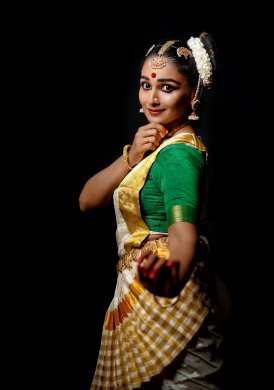 Vidya Pradeep The first performer was Vidya Pradeep, a Mohiniattam dancer, mentored by Dr. Anupama Kylash, a scholar and senior practitioner of Kuchipudi and Vilasini Natyam. Before the event, a very young and vibrant Vidya, while talking about her performance, explained that the objective of her concept was to explore dhwani and the unspoken word in literature through dance. I thought that the word 'Malyada' sounded like 'maryada', which can mean the appropriate manner of speech. The literary content at times may have an implicit meaning which, when translated to dance, gives the feeling of chamatkar or wonderment. So you have to explore both the implicit and the explicit meaning of the words in the poetry. Or more appropriately, while dancing to suggestive poetry. In these verses, the beauty of Godha or Andal is elaborated from the perspective of the narrator. As we know, the tale of Godha was that she was totally in love with the lord, so much so that when she would make a garland of flowers, she would try the beauty of it on herself first before offering it to the lord. Vidya wore an aharyam of white, gold and turquoise in the classic Mohiniattam style. She described the beauty of Godhamba. As Godhamba enters the sanctum sanctorum, her eyes go up to the face of the swami. These beautiful eyes have been given the metaphor of a fish. Then the narrator asks whether Madana deliberately chose the fish as his insignia on his flag, since his fish-shaped eyes are the first weapon of beauty. Godha's face is lit up like the moon. Her swaying, thin waist is like the stem of a creeper which entwines the swami's body. Spring season is in the air. She is enamoured by his face, feels him everywhere around her, feels his touch in the breeze. It is the prakriti devi which has dressed her up like that. Her bosom has blossomed and her face is glowing. The peacock dances when it sees her hair. The video was shot on a stage which was stark and had dark blue curtains. Her aharyam was picture-perfect. She took on the posture of Andal with one hand, showing the bun on one side of her head. The lord is reclining on the sesha as she looks at him with radiant eyes. Vidya moved her eyes upward in a very subtle manner. As her face glows and her breath is fragrant to attract the swami, her breasts too have blossomed to lure him. The dancer has to be very subtle and sensuous to depict this text. And I think Vidya was very gentle, sensitive and leisurely in showing all the features of the heroine as she is waiting for a union, and she actually lived the abhinaya. Godha thinks that Manmatha is throwing his arrows at her and Rati is playing kinnara's music to create this scenario. Probably Lakshmi has sent her son Madan to fight with her. The form of the swami is like the temple; his face is like the mansarovar, she hears him everywhere, and the gentle breeze caresses her like his hands. This was all shown through mukhabhinaya and eye movements. Vidya's eyes were especially expressive. Finally, she added a sequence of nritta showing the narrator's view of Godha's beauty, her face, her dark hair which is mistaken for the clouds by the peacocks. Her beauty makes the flowers bloom; her soft feet give moksha to the bhaktas. The piece culminated in aarti and dance in ecstasy. Vidya very sensitively created the ambience of love and romance, and just as the poetry kept its maryada, so did Vidya's creation through dance. Anupama Kylash is a wizard with poetry and literature and that worked perfectly for Vidya Pradeep to create literature through her dance, with the gentle swaying movements of Mohiniattam and her very expressive eyes and face. Pavitra Krishna Bhat mentored by Dr. Neena Prasad 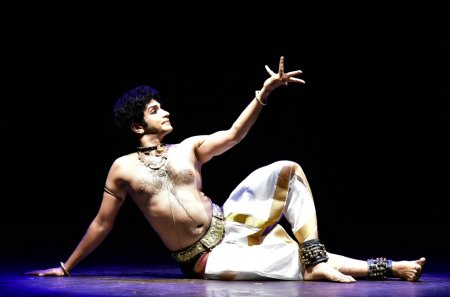 Pavitra Bhat (Photo: Anoop Arora) The second performance for the day was by Bharatanatyam dancer Pavitra Krishna Bhat, mentored by Mohiniattam exponent and researcher Dr. Neena Prasad. The performance was called 'Krishnarth' and depicted Krishna's life as a human being with emotions that ordinary mortals feel. Pavitra began his performance on a stark stage again and wore a blue dhoti. As Krishna, he was seen sitting down, with a lot of anger and frustration pent up in him. In the background, you could see images of Krishna feeling the shackles and dancing in frustration. And to the sound of drums coming from multiple sources stereophonically, Krishna then remembers his life in Vraj, where he would take care of his calves. He played on the flute and danced with gopis in raas. Suddenly, his life in Vraj came to an end when he was taken away to Mathura and made the king of Dwaraka. And then followed the events of the Mahabharat, where he was with Arjun as his friend and then charioteer. Shlokas from the Geeta were recited -yada yada hi... - and Krishna again felt the agony of leaving his life behind, which came to him as snakes biting him and attacking him. Krishna begins to think of the curse that Durvasa Rishi had put on his clan, to end the Yaduvanshis, and he begins to think of Arjun, his very dear sakha, almost like a shadow to him, and his various names come to him: Kaunteya, Partha, Dhananjaya. Pavitra's interlude of nritta carried forward the mood of his reminiscences of his previous life. Krishna says he does not have any other need for material things or any kind of comfort except for the need to be with his friend. There is a beautiful poem that was recited before showing the end of Krishna's life as a human: In the twilight of life has come the thought of my friend, My attachment to you cannot be broken, even though I might be separated from my own shadow, You rule the Geeta of my heart and mind, my friend, My heart wonders whether you are an illusion or really here with me, God yearns for man today, the eyes crave a glimpse, In the inexorable cycle of life and death, penance and curses are both realized, At the end of life, in the hour of the final separation, I remember Parth again In the image behind Pavitra, the expressions were highly painful, showing the anguish of Krishna at the end of his human life. He suddenly feels the angst of a separation from Arjun. Pavitra has great credentials as a soloist. He has the perfect technique, gestures and postures. But as he said in the talk later, this piece required him to portray many emotions. That of being a friend in childhood to Arjun - he would play with him, since Arjun was a first cousin to Krishna and they grew up together. Arjun was also married to Krishna's sister, and Krishna chose to be Arjun's charioteer in Mahabharat; they had deep camaraderie. Krishna gave him the Geetopadesh. They were together in almost everything. Krishna was the sakha of Draupadi. Arjun was the nar (human) that Narayan yearned for and mourned for, he was his chhaya (shadow). The pain and anguish was immense and Pavitra rose to the challenge and depicted it well. I suppose the calibre of dancer he is, he will work on whatever shortcomings there were. It was a deeply emotional piece and Pavitra, who is a dancer of great agility, successfully performed the feelings of pain and angst. Namrata Mehta mentored by Vyjayanthi Kashi 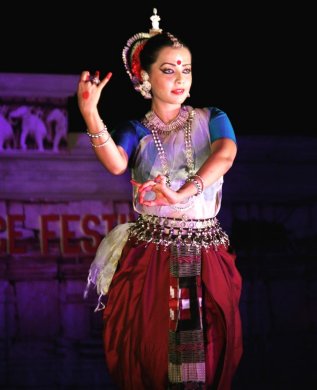 Namrata Mehta On the second day of Pratiroop, there was only one performance, that of Odissi dancer Namrata Mehta mentored by Kuchipudi guru Vyjayanthi Kashi. The stage was stark except for one focus light in the background. The aharyam had subdued colours but even in that, she introduced the blue dupatta of Radha and the half-yellow costume of Krishna. The concept was again based on Krishna, but with a different aspect of his being. This was called 'Krishnamayi'. This is about Radha in the golokdham in the heavens, where she experiences Krishna everywhere. She does not feel the pain of separation from him and is dressing like him in the blue of the sky, the peacock feather and the flute. And Krishna meets her there as he comes seeking her. The composition is about the conversation between the two. The composition was in Hindi - 'Aap hi Shyam Shyam ratat (chanting), pyaari aap hi Shyam bhayi' (as she chants the name of Shyam, Radha has become him). Radha wears Krishna's kundal and peacock feather and plays on his flute. She is looking at her reflection in the water and sees Krishna. She is elated and dances around. In contrast, Krishna says, 'O Radhey, pal smaran tumhara kya main tyaag saka? - (O Radha, was I able to give up your memory for even a moment?) Krishna is anguished by the separation and carries in his heart a reminiscence of being away from Radha. Radha, on the other hand, says, 'Swayam ko nahin akela paya, na socha na hi ashru bahaya, sammukh rahe hamesha tum, nayan mein base rahe tum' (I never found myself lonely; neither did I mope nor did I weep; you were always in front of me, you were always in my eyes). Krishna was always there in her heart and breath. And that prevented her from feeling the pangs of separation. Namrata, with her abhinaya, very sensitively portrayed the two emotions that both the eternal lovers experienced. Radha had spent her time listening to the birds, caressing the calves and playing with the peacock. Even these creatures are confused as they gaze at her: is it Radha or Krishna? There was a shadow of Krishna behind Namrata as Radha in this scene. As she holds Krishna's hands and caresses them, she is taken aback. Those petal-like, soft hands had become callused over the years. She wonders if it was due to fighting with the Sudarshan chakra in his hands. Krishna explains to her the karma and dharma of life, where he had to battle and go through the four stages of life in the cycle of birth and death. After that, Namrata took the Surdas padavali 'Mero mukh neeko ke tero Radha pyaari' (Is my face beautiful or is yours, dear Radha). The lyrics of the padavali are a reflection of their love. The vocalists breathed life into them: 'mero mukh chanda ujiyaro, tumharo mukh ren andhiyari' (my face is the radiant moon, yours the dark twilight), referring to their complexion. 'Tumhare nayan me moto kajara, more nayan me tum banvari' (your eyes are lined thickly with kohl, but my eyes are filled with you, Krishna, you reside in my eyes). 'Tumhare nakh par giridhar raje, hamare hiye me tum giridhari' (you bear the great mountain on your little finger, but I bear you within my heart): since you reside within me, I am more beautiful. Namrata picked up the pace with nritta, raas, leaps and claps, and nat nritya like Krishna. She culminated her nritta with hands rotating around each other up and down in a lotus gesture, as if showing the intermingling of the two souls. The final image of Radha and Krishna was a rare one, since mostly it is Shiva and Parvati who are shown to be so. It showed Radha and Krishna submerged into each other and yet, maintaining half their own identity as ardhanareeshwar. Vyjayanthi Kashi is a guru par excellence in her technique and abhinaya. Namrata is certainly going to flower under her mentorship. For this theme, the time that was given to the dancers was very little to become one with the theme and to internalize it, but if Namrata intends to work on it, her expressions as Krishna and Radha are certainly going to become more sensitized. Even the time given to them for showcasing the production was very little; the production can be made into a full-fledged 45-minute to one-hour composition. For example, the loose ends were left at what Krishna was going through in his lifetime as he went through the four stages of life, whereas Radha in her eternal abode and her undying love remains the same all throughout. That aspect of the composition also needs to be worked on. Otherwise, the conceptualization, the choreography, the abhinaya and the nritta all were very sensitively executed. Namrata's dance certainly had lyricism for the theme. Arundhati Patwardhan mentored by Sharmila Biswas 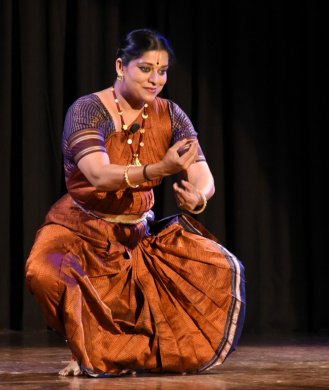 Arundhati Patwardhan (Photo: Anoop Arora) On the third day, it was Bharatanatyam dancer Arundhati Patwardhan, mentored by Sharmila Biswas. The title, very aptly given, was 'Me, myself and I: Emergence'. Arundhati wore a grey sari and a red dupatta. One thought provoking quote Arundhati gave was that laya produces turbulence and this turbulence in turn produces laya. We find laya in all nuances of life. The cycle of birth, upbringing and death is inevitable. There is always a pralaya. As the breathing starts a life, time starts with laya to pralaya, the end. The quest is to find me, myself and I. As the performance started, two circles were lit up on the stage. Gradually, the third also lit up. These were the three identities that an individual tries to find. Arundhati danced between the three zones. The music for this piece was inspired by contemporary music. Finally, she sat in the centre with her hand tapping. She went down in a squat position and her hands interlocked in the front. The hands and fingers moved to show the life breathing in the womb, moving up and down as well. The voiceover said, 'I am experiencing the world and reaching out to it from within.' With the ghatam, kanjira and the contemporary music playing, the effect was captivating as Arundhati portrayed the life within emerging. She showed different emotions, sometimes happy, sometimes sad, sometimes frustrated, while dancing within the three circles. Par, kintu, parantu, kuthe - these are the questions that emerge from within. Who am I, my purpose, my quest for answers for who I really am. At the same time, her hands moved in front, sideways and up and down, then sprouting like a creeper moving upwards. Particularly remarkable was a step that she did with a sharp leg lift. Further on, the voiceover, which Arundhati had done, said that interactions are happy and satisfied, my words cut me, I drown them out: all conflicting emotions that a person feels. All throughout, with bols, she covered the entire stage. And finally, it culminating with her saying, look out, I am marching now, I am what I was meant to be, I am kind, samvedansheel, nirmal, I am what I was in the womb, brave, bruised, and I am not apologetic about what I am. Arundhati danced with her formidable technique and energy in Bharatanatyam, almost all throughout covering the entire stage within the three spheres of light which I think represented the three spheres of me, myself and I. The technique was, of course, flawless, with the music which was composed very sensitively. Through the short piece, she brought out an abstract concept where it was not only about the female gender which can breathe and be what she is all her life without any restraint or being apologetic about it, but I think it was also about being a free thinking individual belonging to any gender and blossoming into a compassionate human being. Sangita Chatterji mentored by Rama Vaidyanathan 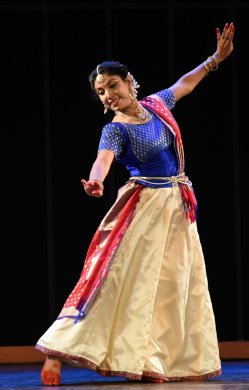 Sangita Chatterji (Photo: Anoop Arora) Kathak dancer Sangita Chatterji performed 'Manthani: The vessel', mentored by Bharatanatyam dancer Rama Vaidyanathan. Sangita wore a brown, dark and light costume. The stage was stark. The concept was that in these times, when the pandemic has struck all of creation, every human being should continuously be churning their mind since the mind and consciousness are constantly battling. 'Kaiso kolahal': what is this upheaval about? The mind flickers, desires pull it apart. 'Kolahalnij se niksat': it is coming from within. Let the churning continue. Life is a vast ocean, the vessel is the body. The mind is continuously churning it, the param manthani - the primary vessel for the churning. This atmamanthan (self churning) is like the amrit manthan (churning the ocean for nectar). Sangita began her performance by actually showing her body as a vessel in which the manthani is rotating. Using her hands as the manthani (vessel for churning), she went around in different patterns with different footwork each time, and different rhythm. She kept rotating in half and full circles with the rhythm and beats. And then suddenly, the balance disrupts, the movements are not smooth, and are forced into jolted, imbalanced movements. One hand is trying to force the other hand to move but the movement does not happen. 'Kaiso kolahal kahe sanshaya, man vyavahal' (What chaos is this, what doubt? The heart is unsettled) said the poetry. She did the rotation on her knees. 'Kahan hovat ghan ghan manthan' (Where is this thundering churning). She kept on showing the movement of manthan to and fro with quick movements of hands and footwork. 'Man mandar rayo achal aap kaanpat hoye vikal' (the heart is like the mandar, unmoving, but the self is trembling and perturbed). She went on to show the Vasuki snake which are the desires of her mind, which is wrapped around the mandar parvat (mountain) and is making the mountain move to and fro with its force. But it too loses its rhythm and starts getting pulled on both sides: 'kahe hot kheencha taani' (why am I being pulled this side and that). The snake is being pulled helplessly from both sides: 'vayu anant jal karat manmani, vasuki garal samaan' (the boundless wind and water wreak havoc like the poison of Vasuki). On one side it is the Vasuki snake which is being pulled, and the other side, it is the manthani which is losing its balance. 'Mukh se nikase vikat vishal halahal' (the poison is choking the body or the vessel). After a short nritta portion, she shows how, as the poison spreads, all creation is dying. But as the human takes control of his mind, it is now the pot of nectar which shall overflow. The flowers and animals are again blossoming. It is the breath and prana which again take control of the manthani. Sangita is a dancer who puts a lot of thought into her dancing. Through her dance, she conveyed the concept very well. In fact, her body did not move with the form but with the thought in each instance. It was indeed a manthan (churning) of emotions. Pranamya Suri mentored by Prerana Shrimali 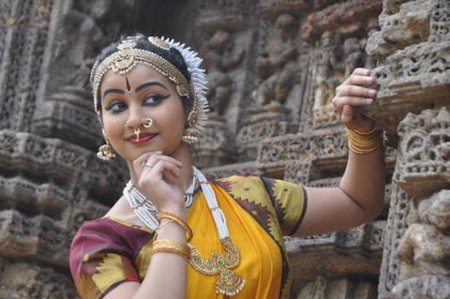 Pranamya Suri Delayed by a few days, it was Kuchipudi dancer Pranamya Suri performing under the mentorship of Kathak guru Prerana Shrimali. The composition was called 'Varsha'. The introductory note said, '...invoke the mighty Parajanya, the god of rain, delight on his showers and roar of thunder'. He moves like a charioteer with a whip in his hands, and inspires the rain horses to leap forward. The thunder roars like a lion, the heavens are enveloped in darkness. Life on earth is being nourished. Pranamya chose to depict the piece with just footwork, with the focus on her red painted feet. The footwork was very precise and followed the rhythmic jatis with agrataal in nritta, but the import of the composition could not be conveyed. It was a different perspective, however. The aharyam was blue with a stark stage. In the synopsis for the next piece, the literature said that the peacocks and deer are rejoicing. The maiden lets go of her inhibitions. The blind man enjoys the feel of the rain but a widow mourns the loss of her lover as she sees the skies weeping. The expressions that Pranamya started with were very subtle. With a slight smile, she moved her eyes up and down as if looking at the drop of rain falling. She danced as the peacock and the deer frolicking, and then the innocent maiden lets go of her dupatta. The blind man, bewildered at first, enjoys the rain. The act was done expressively. The desolate widow laments her loss. Then follows the destructive character of the rain. The waves are crashing on the shores, the winds are destructive, rivers are flooded. There is storm raging within and without. The cyclone brings with it destruction and isolation. The destructive forces, like huge waves, storm and lightning, were shown through gestures and expansive leaps. But it was the jatis, bols and nritta that created the feel of a storm. As the storm builds, one shuts oneself in the house, bolting the doors and windows. The dancer compared her internal state with what was happening outside in nature. Thick clouds had gathered and the sky was overcast. The thunder was like elephants moving or horses galloping and the snakes slithering on the ground. Inside the mind too, the thoughts are hovering and clouds of uncertainty build up, feeding on the fear. Pranamya depicted the elephants through their gait and the horses galloping. The snakes slithered in a cloud of smoke. The rains have brought relief to the earth but the fear and gloom are preventing me reaching you. The bhakta waits for the clouds to clear and the union with the Lord. The Meera bhajan for this part, 'Badal dekh dari', was sung very lyrically. Pranamya, sitting with the iktara in her hand, prays to the Lord to let the rain quench her. She imagines him standing and tries to hold him in her arms. The nayika whose lover is not with her is getting wet alone in the rain, waiting for him. Here, some superimposed images were used to evoke the separation and ecstasy together. The beseeching bhakta pleads, 'Your chakra (disc) is the lightning and your shankha (conch) creates all the rumbling and instead of showering me with the arrows of separation, please shower me with your grace.' She showed Padmanabha reclining on his snake bed on the ocean. And finally comes the much awaited union, when the outside and inside are coming into tandem. The smaller beings are swimming in water, the earth has become green again, the flowers are blooming. As the outside world sees a quenching of thirst, so does the soul. Nature becomes the symphony that purifies the soul. The insects are crawling, the birds have flown, the bees hover, and the fish frolic in water. The lightning and the rain all beautify the earth. The nayak looks for the nayika and gives her the shelter of his arms and scarf. The love is all-pervading in nature. This is an interesting process of letting a younger dancer be mentored by a senior guru of a different form of dance. So you cut across not only the pedagogy but also the form of dance, and then go on to make a thematic production. It is still difficult to say about the success of the process but from the post-performance talk, it was clear that all the mentors and the mentees enjoyed the process and were keen to take it forward to a bigger production. 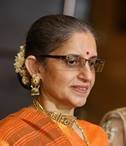 Shveta Arora is a dance-mad writer who chronicles classical dance events in Delhi. Ten years ago, she started the blog Kala Upasana at delhiculturecomment.blogspot.com, where she began posting her own writing along with photographs clicked by Anoop Arora, her husband. She's been dancing all her life as a devotee, but resumed her formal training in Kathak in her 50s and has passed her fourth year Kathak exams. |